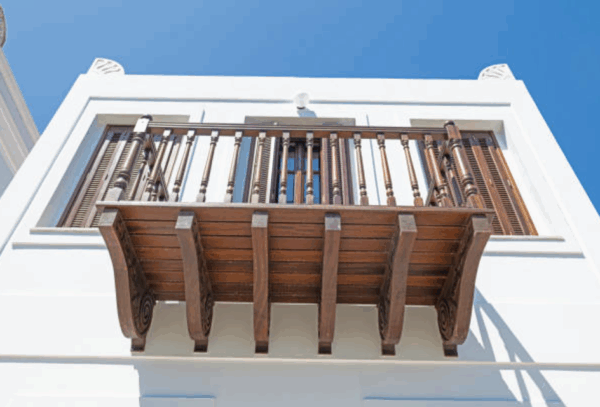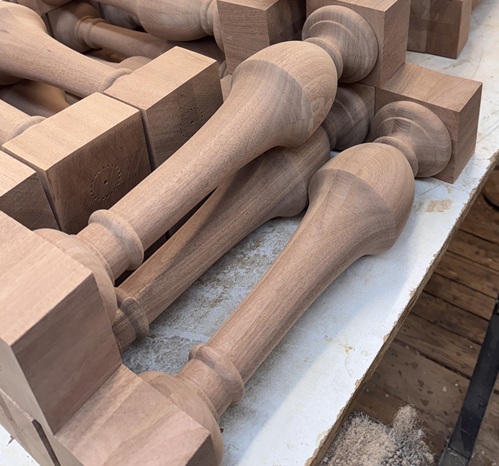Choosing Balcony Balusters: Why Wood Still Leads
If you’re thinking about updating your balcony, choosing balcony balusters may be the design difference that finally ties everything together for you. They have been a design staple for years, keep you and your guests safe, and, with the right touches, bring a uniqueness to your home.
There are a lot of balcony materials to choose from, such as steel, stone, and composite. However, let us be the first to say that wood still leads the way in 2025. It’s reliable, good-looking, and works with many different home styles. More homeowners and builders are choosing wood because of its long-term value and design flexibility.
In this guide, we’ll go over the main types of wooden balusters, why wood is such a smart choice, and how to take care of them over time.

Custom Wooden Balcony Balusters on Outdoor Residential Railing
Custom-turned wood balusters add warmth, safety, and style to this modern balcony railing.
Wooden Balcony Balusters: Styles You Should Know
Picking the right baluster style depends on your home’s design and your personal taste. Making the right choice can improve your balcony’s appearance and also its overall feel. Wood gives you a wide range of design options that work for everything from historic homes to modern builds.
Classic Turned Wood Balusters
These are the pieces you often see on older homes. They have simple curves and details that are a perfect fit for Colonial, Victorian, or Craftsman styles. They also offer a look that has never gone, and will never go, out of date.
Modern Flat or Square Styles
If your home has a modern look, square or flat wood balusters could be a good match for you. They’re simple and smooth, giving your balcony an updated feel. These work great for minimalist designs and are often easier to clean and maintain.
Custom-Cut Designs
Due to its moldable nature, wood can be cut or carved into just about any shape. You can choose from twists, flutes, or even floral patterns. These balusters turn your balcony into a unique design feature and let you express your style in a personal way by using shapes that are all your own.
Why Pick Wood for Balcony Balusters?
Balconies need materials that last, look good, and feel comfortable. Wood checks all those boxes. Let’s look at what makes it such a great choice below.
Easy to Customize
Wood can be carved, turned, or shaped into almost any design you would like. It’s great for both builders and homeowners who want something unique. At H.A. Stiles, we make small and large batches of custom wood parts to match your exact needs, making it easy to keep things consistent across big projects.
Simple to Repair
If one wooden baluster gets damaged, you can replace it without tearing out the whole railing. This saves time and money, especially on large balconies. You can also sand or patch small areas without special tools, which makes long-term maintenance easier.
Comfortable to the Touch
Wood doesn’t get super hot in summer or ice-cold in winter like metal does. This makes it more pleasant to touch year-round, especially while spending time outside on your balcony during the warmer months. If your balcony gets a lot of direct sun or chilly wind, this is especially beneficial.
Stands Up to Weather
With the right finish, wood can handle rain, sun, and snow with ease. A good stain or sealant helps stop swelling, fading, or cracking over time. When cared for properly, wood can last just as long, if not longer, than many metal or composite options.
You Can Change the Look
Tired of the color you chose originally? Think you might want a change in the future? You can repaint or re-stain wood to refresh its look without replacing it. This gives you the freedom to update your balcony’s style as your tastes change over time. It also means your investment goes further.
Built with Precision
Need many balusters that match perfectly? Wood is easy to shape with machines that cut clean, detailed patterns. It’s great for both simple shapes and detailed designs. Your finished product, therefore, looks sharp and professional every time.
Lighter Than Stone or Concrete
Wood is much lighter than materials like stone or concrete. This makes it easier to install and puts less stress on your balcony structure, which is useful for upper levels or balconies with limited support.
Less Slippery
Wood has a natural texture that provides a better grip. When finished with a matte or textured sealant, it becomes even safer. This helps reduce the risk of slips, especially in areas of the country with lots of rain or morning dew.

Exterior Sapele Balusters – Close-Up of New Turned Parts
Newly turned Sapele exterior balusters, crafted for outdoor installation and historical accuracy.
What to Keep in Mind When Choosing Wood Balusters
There are a few important things to think about before you order or install wooden balusters. Getting these details right will help you avoid problems later on.
Here’s what to consider:
How to Take Care of Your Wood Balusters
With a little upkeep, wood balusters can last for many years. Regular care helps keep them looking great and prevents damage from weather.
Follow these steps each season:
The Bottom Line: Wood Balusters Just Make Sense
If you’re a builder, contractor, or homeowner looking for balcony balusters that offer style and performance, wood is still the best material to build with.
At H.A. Stiles, we specialize in small, custom orders and high-volume wood manufacturing for exterior components like balcony balusters, stair parts, and more. Every piece is made to your exact design, species, and scale requirements.
Request a free, no-obligation quote today and see how we can support your next project with precision-made wood parts built for outdoor durability.
Frequently Asked Questions (FAQs) for Balcony Balusters
To estimate how many balusters you’ll need, divide the total linear inches of your balcony railing by the desired spacing (typically 4 inches) and add one. A manufacturer like H.A. Stiles can help you calculate exact quantities based on your layout and code requirements.
Absolutely, but you’ll need to choose the right species and finish. Woods like ipe, teak, and mahogany will perform well near saltwater. Regular sealing is critical to protect against moisture and salt air.
If you notice any fading, peeling, or water absorption (wood darkens when wet), it’s time to refinish. On average, you should reapply sealant or paint every 2–5 years, depending on how much it has been exposed to moisture and the sun.
Yes. Most U.S. building codes require that balcony balusters are spaced no more than 4 inches apart and meet minimum height requirements for the railing. Always check your local code before ordering or installing any components.
Yes. Many homeowners and designers combine wood with metal rods or glass panels for a mixed-material look. You’ll want custom wood balusters that are milled to match the connections and mounting style of the non-wood components.
For balconies, top-performing wood types include cedar, mahogany, redwood, pressure-treated pine, and others. These woods are naturally resistant to rot, bugs, and humidity. Contact us to see which species could work best for you and your needs!
Indoor balusters tend to focus more on aesthetics and don’t need to be able to handle weather. Outdoor balusters, especially for balconies, must resist moisture, direct sun exposure, and temperature changes. That’s why wood species and finishes matter that much more for exterior use.
